 FEEDBACK: She said WHAT? Read what people think about our Classical Music Daily features, and have your say!
FEEDBACK: She said WHAT? Read what people think about our Classical Music Daily features, and have your say!
 DISCUSSION: What is a work? John Dante Prevedini leads a discussion about The performing artist as co-creator, including contributions from Halida Dinova, Yekaterina Lebedeva, Béla Hartmann, David Arditti and Stephen Francis Vasta.
DISCUSSION: What is a work? John Dante Prevedini leads a discussion about The performing artist as co-creator, including contributions from Halida Dinova, Yekaterina Lebedeva, Béla Hartmann, David Arditti and Stephen Francis Vasta.
 DISCUSSION: John Dante Prevedini leads a discussion about Music and the Visual World, including contributions from Celia Craig, Halida Dinova and Yekaterina Lebedeva.
DISCUSSION: John Dante Prevedini leads a discussion about Music and the Visual World, including contributions from Celia Craig, Halida Dinova and Yekaterina Lebedeva.
A Different Aida
Denis Krief's new production in Rome,
experienced by GIUSEPPE PENNISI
Teatro dell'Opera di Roma's summer opera season was inaugurated on 4 July 2019 with a new production of Aida at the Baths of Caracalla's huge open-air theatre. I was in the audience. For Romans, 'Aida at Caracalla' is like macaroni cheese, ie the daily staple meal, yet Aida has not been staged at the Terme di Caracalla for eight seasons. This new production is conceived by Denis Krief (stage direction, sets, costumes and lighting), with Jordi Bernàcer in the pit. The main singers are Victoria Yeo (Aida), Alfred Kim (Radames), Judit Kutasi (Amneris), Marco Caria (Amonasro) and Adrian Sampetrean (Ramfis). The other soloists - Domingo Pellicola, a messenger, and Rafaela Albuquerque - a priestess - come from the project 'Fabbrica', the opera finishing school at Teatro dell'Opera . The choirs and dancers are, of course, from the theatre company.
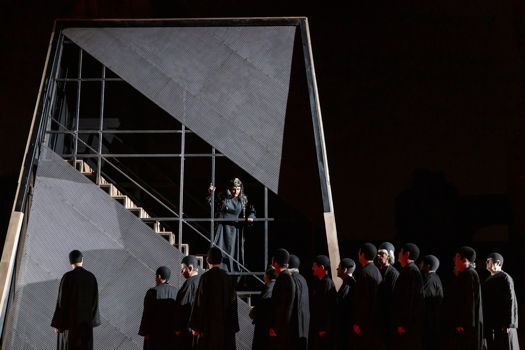
Judit Kutasi as Amneris in Denis Krief's new production of Verdi's Aida in Rome. Photo © 2019 Yasuko Kageyama
The production is innovative and almost disruptive when compared to traditional summer open-air performances. Yet, at half past midnight, the 4,500 listeners and viewers erupted in accolades. There had been applause after major arias, duets and trios as signs of appreciation for the 'revolutionary' staging - an eloquent sign that the audience is changing. Many young people were in the open-air theatre (in addition to the many authorities who don't, or can't, miss a debut).
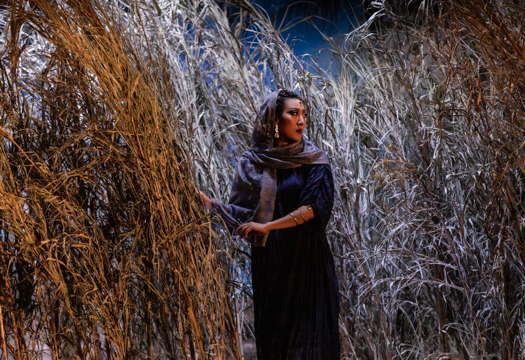
Vittoria Yeo as Aida in Denis Krief's new production of Verdi's Aida in Rome. Photo © 2019 Yasuko Kageyama
For decades, there has been a curse on Aida, one of Giuseppe Verdi's most beautiful and most performed operas. It is a curse like that of Tutankhamun, to remain in Egyptian themes: to be considered a 'colossal' three ring circus, or so, for summer shows in arenas where the presence of horses, camels and elephants is more important than what happens in the orchestra pit. Also, shouting by the singers seems to be more important than legatos and diminuendos.
Way back in January 1969, I was in the audience for some performances at the Opera House in Cairo (where Aida had its debut in 1871 as commissioned by the Khedive of Egypt for a double event - the opening of the Suez Canal and the inauguration of an Italian style theatre). Few people know that Italian was the language spoken at the Egyptian Court; in the 1950s, King Farouk was the first of the dynasty to be able to speak Arabic. Cairo Opera House was a charming theatre with tiers of boxes similar to the Teatro Valle in Rome. It had just over seven hundred seats. In January 1969, a traveling company of the Staatsoper Unter den Linden, then at the heart of East German socialism, staged minimalist arrangements of works by Alban Berg and Carl Orff. A fire destroyed the Cairo Opera House in 1970. It was then rebuilt in the 1990s with modern architecture.
Commissioned for the theatre I visited in 1969, Aida is an almost intimate opera (with some, however limited, concession to two events for which it had been planned). It incorporates some of the key lessons of Wagner's 'music of the future': above all, the integrity of the continuous orchestral symphonic flow that is never interrupted by 'closed numbers' - arias, duets, trios or concertato - in each of the four act opera's seven scenes.
Recently this tradition has been partly revived. For example, in 2000, Rome Opera managed to have sold out performances by brushing up a 'minimalist' production, conceived in the 1970s by Mauro Bolognini (when John Cox prepared a similar Aida at New York Metropolitan Opera). Essential scenes (on two levels) by sculptor Mario Ceruli, hieratic choreography by Ricardo Núñez (and with all dancers semi-nude) and functional sets and lighting, especially important to distinguish the full midday of the second part of the second act (that of the Egyptian military triumph) from the middle of the night of the third act (that of the Nile). Since it was easily 'portable' and 'exportable', Rome Opera has managed to sell or rent it to fifteen other theatres; it was recently revived at La Fenice in Venice.
The late Franco Zeffirelli produced a minimalist Aida for Busseto Theatre - some 130 seats including three tiers of boxes - in 2001, the centenary of Verdi's death. The sets were painted in art deco style, the acting was very accurate, and there was only one dancer - Carla Fracci. The production toured Italy for three years: it will be revived again next October at the Verdi Festival. There were some fifty young instrumentalists in the pit, as most likely in Cairo in 1871, not one hundred and twenty as in the Verona Arena.
Returning to the production seen on 4 July, this Aida, conceived by Denis Krief, is intimate. There are signs of Egypt, such as the pyramid that becomes a tomb for the two protagonists.
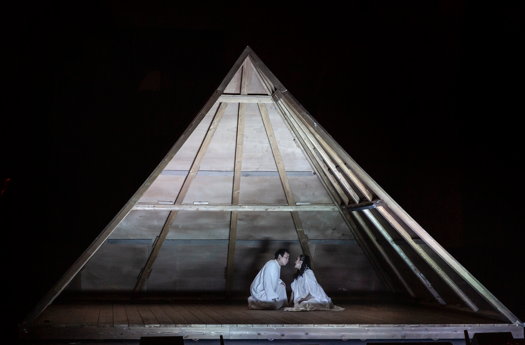
Alfred Kim as Radames and Vittoria Yeo in the title role of Denis Krief's new production of Verdi's Aida in Rome. Photo © 2019 Yasuko Kageyama
In order to facilitate the voices, the action takes place, to a certain extent, within cubes where there are reproductions of the scenes on canvas that marked the debut in Cairo in 1871.
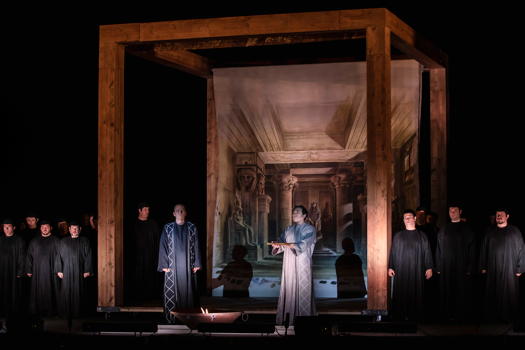
A scene from Denis Krief's new production of Verdi's Aida in Rome. Photo © 2019 Yasuko Kageyama
In the triumph scene, the King and Princess Amneris are in a box similar to those of the Parisian Palais Garnier - symbol of the French Second Empire, contemporary to the conception of Aida.
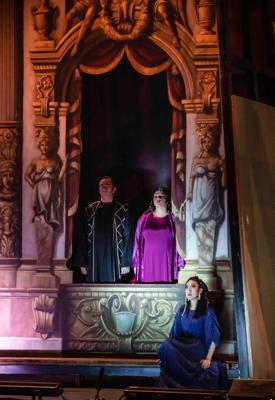
Gabriele Sagona as the King, Vittoria Yeo as Aida and Judit Kutasi as Amneris in Denis Krief's new production of Verdi's Aida in Rome. Photo © 2019 Yasuko Kageyama
There are a limited number of extras and, of course, no animals on stage. The costumes are timeless, the dances choreographed by Giorgio Mancini; those of the second scene of the second act are inspired by Egyptian hieroglyphs, and very good acting and lighting. Within this context, Aida tells primarily the timeless drama of a love triangle where Amneris is the character with greatest psychological development.
In the pit, Jordi Bernàcer, recently admired in Rossini's La Cenerentola - read 'A Mechanical Toy Box', 15 June 2019 - and the orchestra extracted all the elements of the 'music of the future' from the score: the intertwining themes, the symphonic approach, the sung declamation that flows into arias, arioso, duets and trios. The 'pianissimo' initial string attack and similarly the 'pianissimo' finale were perfect in this huge outdoor theatre. These are the real keys to understanding the intimacy of this score.
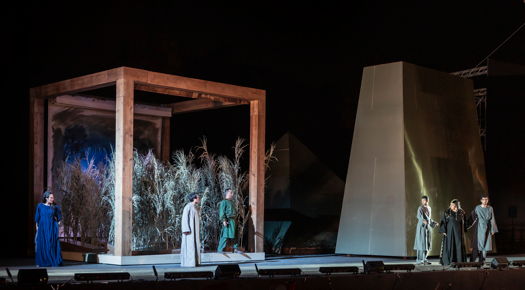
Vittoria Yeo as Aida, Alfred Kim as Radames, Marco Caria as Amonasro and Judit Kutasi as Amneris in Denis Krief's new production of Verdi's Aida in Rome. Photo © 2019 Yasuko Kageyama
Vittoria Yeo and Alfred Kim, as, respectively, Aida and Radames, are two Koreans who have been singing on Europe's major stages for years. Vittoria Yeo gives us an Aida passionate and tormented, and applauded after 'Numi Pietà' and 'O Patria Mia'. With Kim, and Marco Caria's well-rounded Amonasro, she had her best moment in the trio of the third act - 'Le Gole di Napata!'. Kim is a Radames similar to Tucker: she has a clear and beautiful voice, combined with a great legato. He was acclaimed after the opening scene and aria 'Se Quel Guerrier io Fossi'.
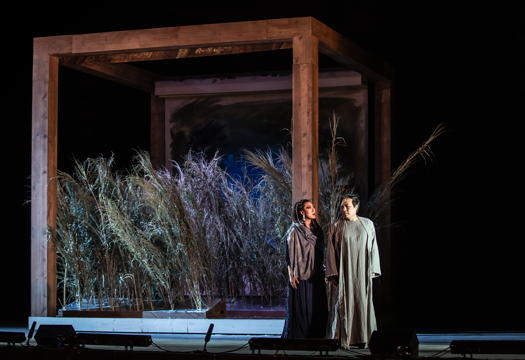
Vittoria Yeo as Aida and Alfred Kim as Radames in Denis Krief's new production of Verdi's Aida in Rome. Photo © 2019 Yasuko Kageyama
Judit Kutasi is a Romanian mezzo soprano who, as Verdi wanted, can go down to a very low register, particularly in Act IV's 'Già i Sacerdoti Adunasi'.
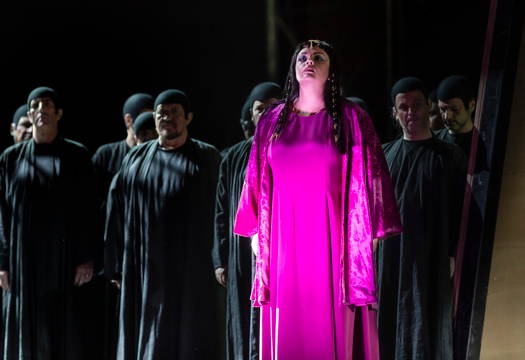
Judit Kutasi as Amneris in Denis Krief's new production of Verdi's Aida in Rome. Photo © 2019 Yasuko Kageyama
In short, this was a great show to revisit in order to appreciate Aida's nuances.
Copyright © 10 July 2019
Giuseppe Pennisi,
Rome, Italy



